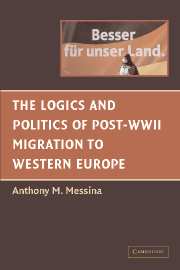Book contents
- Frontmatter
- Contents
- List of Figures and Tables
- Preface and Acknowledgments
- The logics and politics of post-WWII migration to Western Europe
- 1 Introduction
- 2 The Origins and Trajectory of Post-WWII Immigration
- 3 The Organized Nativist Backlash
- 4 Immigration and State Sovereignty
- 5 The Logics and Politics Of a European Immigration Policy Regime
- 6 The Domestic Legacies of Postwar Immigration
- 7 The Logics and Politics of Immigrant Political Incorporation
- 8 Conclusions
- References
- Index
2 - The Origins and Trajectory of Post-WWII Immigration
Published online by Cambridge University Press: 05 June 2012
- Frontmatter
- Contents
- List of Figures and Tables
- Preface and Acknowledgments
- The logics and politics of post-WWII migration to Western Europe
- 1 Introduction
- 2 The Origins and Trajectory of Post-WWII Immigration
- 3 The Organized Nativist Backlash
- 4 Immigration and State Sovereignty
- 5 The Logics and Politics Of a European Immigration Policy Regime
- 6 The Domestic Legacies of Postwar Immigration
- 7 The Logics and Politics of Immigrant Political Incorporation
- 8 Conclusions
- References
- Index
Summary
We wanted workers, but people were arriving.
(Max Frisch 1983: 416)If Germany maintains a net immigration at 200,000 yearly … the decline of the German population will be limited to 12 million people. Without immigration, it will shrink by 23 million people compared to 1999/2000.
(Süssmuth Commission Report, 2001)This chapter begins to investigate the puzzle of why Western European states have historically permitted, and to a considerable extent continue to abet, relatively high levels of immigration. Although these questions will be considered more fully in later chapters, we will address them here in the context of the origins and characteristics of post-WWII migration to Western Europe. Before we do so, however, two facts should be underscored. First, postwar immigration did not unfold in a single seamless pattern but, rather, in overlapping waves (1945–79, 1973–2007, 1989–2007). As we will see in this chapter, each of the three major waves – labor immigration, family reunification, and irregular/forced immigration – was precipitated by a unique set of short-term stimuli and governed by its own peculiar logics. The second fact that should be highlighted at the outset of this chapter is that the aforementioned waves of immigration are inextricably linked. Even a cursory examination of the historical and contemporary patterns of migration to the immigrant-receiving countries leads to the inescapable conclusion that the efforts (successful or not) of states to restrict the number of persons entering their territory along any one dimension of migration increase the number of immigrants seeking and gaining entry along other dimensions.
- Type
- Chapter
- Information
- Publisher: Cambridge University PressPrint publication year: 2007



